Piping Plover chick 1 of 4. Day 7. 19 days until fledge day.
Today was our first sunny day with people on the beach.
We all survived without too many ruffled feathers.
🙂
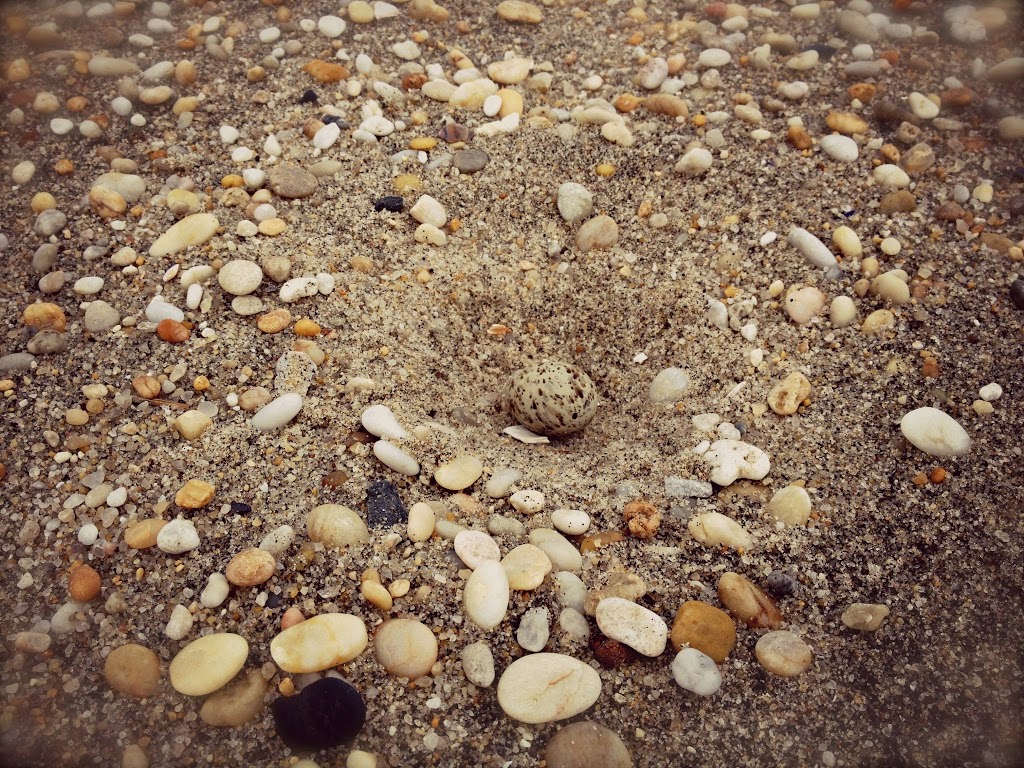 |
| Least Tern scrape |
 |
| American Oystercatcher caginess |
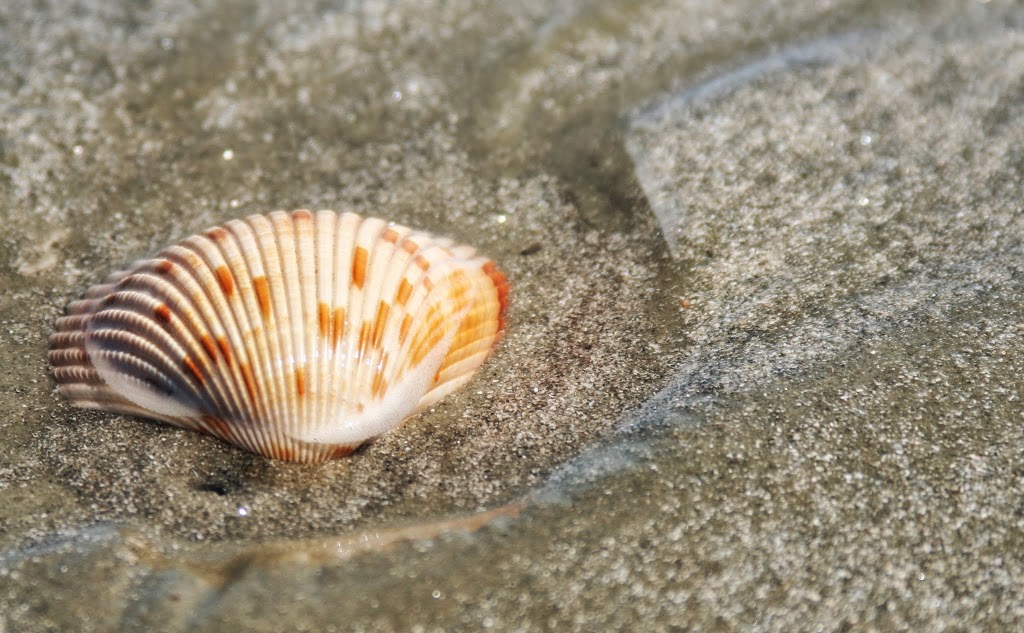 |
| Waiting to be found |
Just as the sun steps over the horizon, head east. Drive with the sun in your eyes until you hit water. Do not think about yesterday’s losses. Do not linger too long over what might’ve been. Do not wonder what you should have done differently.
Climb over the seawall and greet the Oystercatchers on their way to the river. Tip-toe through the wrack and nod towards the grumpy fishermen. Get down on your hands and knees to see what gifts the tide has left you. Do not mind the tears; the sand and the wind in your eyes are a good excuse.
See the Least Terns overhead: the brazen, bustling air-defense system of this beach. Let your eyes map their petite features: the quick wings, the black cap, the downward-pointing yellow bill. Count them by the dozens. Admire the simplicity of their nest: in a pebbly depression of dry sand, eggs 1 to 4, from pale greenish to dull drab, spotted with clear brown and some lavender.
Much of the general beach-going public seems determined to believe that Piping Plovers don’t really exist. Many act as if they’re just an imaginary endangered bird the rest of us have made up to inconvenience dog-walkers or otherwise prevent folks from fully enjoying a day at the beach.
But, I have photographic proof of their existence!
😉
The past couple weeks have been Piping Plover boot camp here. Like the mailman, neither fog nor rain nor blazing sun nor gust of wind stays this courier from the swift completion of her appointed rounds! (The weather has been pretty crappy.) I’m out there on the beach daily trying to piece together tracks and sightings of individual birds to predict where they might nest. There’s been a fair amount of false starts and leads, and a steep learning curve for me, but we’ve got 3 pairs with nests!
I can empathize with the public’s general cluelessness about these birds. They’re really hard to see… even for those of us who are looking for them. They’re designed to be invisible. Just imagine trying to find a tiny bird the color of wet sand on a beach strewn with shell shards. It’s not easy! If nothing else, it gives you a real respect for the power of camouflage. But as a result, the public is left looking at yards and yards of “empty” roped-off beach that they’re not allowed to use and wondering what all the fuss is about.
I spent my afternoon “off” the other day visiting with the plovers out at Sandy Hook. The National Park Service monitors the birds there; I just plopped myself down on the beach with my camera, well outside of the roped-off areas, in order to get a general beach-going public sort of view of them. Just to try and see them the way the rest of the world does (or doesn’t!) PIPLs are very agreeable little birds… if you just sit quietly and still enough, they’ll happily share the beach with you. Every little drama of their lives is playing itself out around us on the beaches…
 |
| I like to feed on the sparkly parts of the beach. |
 |
| The dunes hide me well; they’re a good place to rest. |
 |
| Pebbly and shelly places make me disappear even more. |
 |
| If I position myself just so, I can have a private bath right at your feet! |
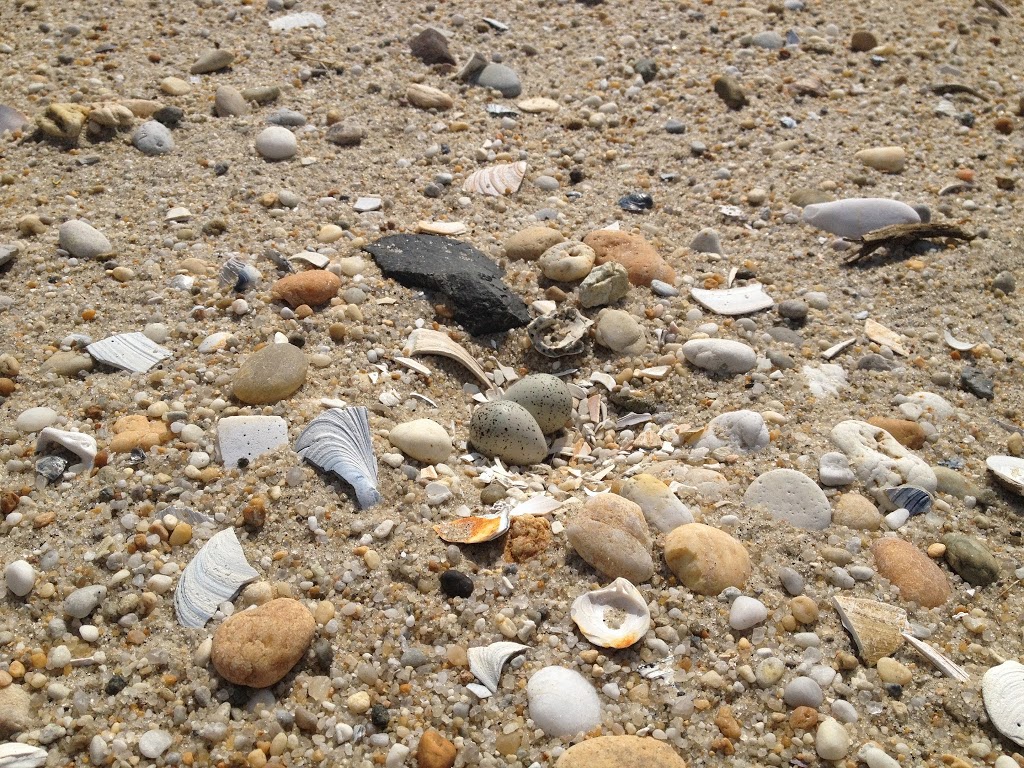 |
| My eggs: a masterwork of disguise. |
Please share the beach.
Please encourage others to do so.
Please help others to see and respect even the hard-to-see wonders of this world.
These birds live here, too. They’re our neighbors. They need our help.
Every day I make “rounds” to the 7 or so sites that I’m responsible for; ideally I get to the beach first thing in the morning while the news is still current. Oftentimes, like any busy person, I just scan the newspaper’s sections for stories I want to read further…
 |
| TRAVEL SECTION |
This story was about a person and a dog breaking the rules. Dogs, even leashed and well-behaved ones, aren’t allowed on most ocean beaches during nesting season. I read this story just about every day on every beach I visit.
 |
| CRIME BLOTTER |
The same old suspects here… crows, of course (I think!)
I’ve been watching a pair of Fish Crows at one site collecting nesting material for the past couple days… I was happy to connect the tracks I was seeing in the Rugosa Roses in the protected habitat to the Fish Crows flying past with sticks. The nearby nesting American Oystercatchers are not happy with this news, tho and chase them out of the neighborhood at every opportunity!
 |
| CLASSIFIEDS – SINGLES ADS |
Headline news in Spring is all about who’s available and where, right? I’m hoping to see this scrape filled up with Piping Plover eggs before very long.
Click to enlarge and see plover tracks!
 |
| SOCIAL SCENE – WEDDINGS AND CELEBRATIONS |
Weddings (and their associated baby announcements!) are the highlight of the daily social calendar published locally. All we beach-nesting bird people can talk about is who’s expecting and when.
: )
This killdeer couple will be happy parents in 22 – 28 days.
 |
| OBITUARIES |
Death notices are published daily and should attempt to give significance and honor to the life lived. Many things that wash up dead each day are surrounded by mystery: a dead loon on the beach isn’t necessarily strange, but how it ended up more than 300 ft. from the ocean wasn’t mentioned in this headline.
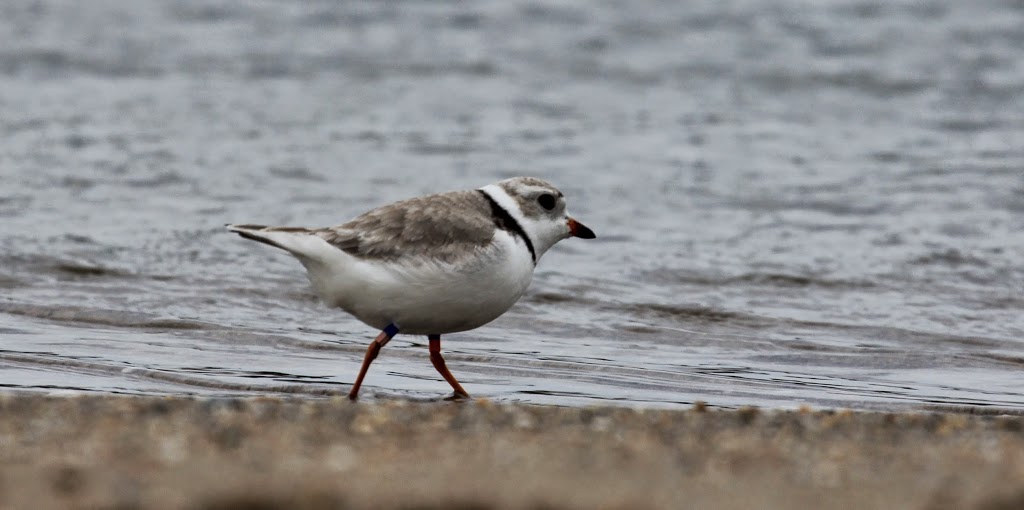 |
| FASHION AND STYLE |
Celebrity Piping Plover “Dexter” is sporting the latest in endangered beach-nesting bird bling… color-coordinated bands!
🙂
(I think I made my boss’ day with this story plucked from the headline news!)
Stayed tuned…
*ALL PHOTOS IN THIS POST WERE TAKEN DURING THE OFFICIAL CONDUCT OF MY JOB TO MONITOR AND PROTECT BEACH-NESTING BIRDS, or, like a local fisherman has taken to calling it “as the official birdwatcher here”.
It’s been a busy first couple of days here in NJ, but I’m loving it! I started off on Tuesday with a boss-led tour of the sites I’ll be responsible for and had some fun looking for American Oystercatcher nests.
My shoes, scalp and ears were full of sand at the end of the day!
I was rained out on Wednesday, but Thursday found me helping out (carrying and holding stuff) on a beach-nesting bird habitat survey and fixing fencing damaged in Wednesday’s stormy weather.
Today I was on my own for a couple of site visits and had the chance to spend a few hours at Sandy Hook counting Piping Plovers for a migration survey. It was a beautiful afternoon and I learned my first important lesson for field work – always have an extra pencil!
I was carrying so much stuff on the death march out the Fisherman’s Trail to the survey site and don’t yet have my scope sherpas (student interns) to help me. I lost track of my pencil three-quarters of the way through the census and had to use moon shells in various pockets to keep a tally of the birds I was seeing!
🙂
 |
| Today’s sunset at the north end of the Chesapeake Bay Bridge Tunnel |
So I guess I finally have enough of my ducks in a row to tell you all about my plans for this summer…
I’m going home to NJ!
The perfect summer job landed in my lap… I’ll be working for NJ Fish and Wildlife to monitor and protect beach-nesting birds.
Piping Plovers!
Least Terns!
American Oystercatchers!
Please don’t anyone pinch me… I don’t want to wake up if this is a dream!
: )
I set out early this morning with my bunny and my African violets and after 12+ hours in the car, we’re all feeling pretty bedraggled. I took the shortcut across the Chesapeake Bay Bridge Tunnel to spend the night on the Delmarva Peninsula and will meet the ferry to Cape May in the morning. It’s beautiful here (and there’s still “sweet tea” available!) and I was treated to Brown Pelicans and frolicking dolphins this evening when I stopped at the scenic overlook on the bridge to stretch my legs. Plus, I can smell the sea again… But it’s cold! I started the day with the AC running in the car and ended it with the heat blasting.
Some Piping Plovers and American Oystercatchers are already on eggs… I’m hoping to arrive on the beach with the Least Terns. I’m so excited! I can’t wait to get started and share this adventure with you…
So last Saturday, I went along on a special guided tour meant for “serious” photographers. I was concerned with not being “serious” enough, of course, but no one checked my credentials.
: )
Granite outcrops are difficult places for the plants that try to make a life there. The temperatures are extreme and there’s not much soil. In fact, the plants arrange themselves into zones according to soil depth. The hot, dry conditions foster plant life that dramatically differs from that of the surrounding forest… many are perennials that grow very slowly; others are winter annuals that survive the desert-like summer months as seeds.
Many of the winter annuals have adaptations like whitish hairs to reflect sunlight and smallish leaves that reduce surface-area water loss; others, like the Elf’s Orpine (pictured here and above) are succulents that store water in swollen leaves and stems.
This environment was a first for many in our small group of “serious” photographers; this lady earned innumerable points in my book for forgoing the tripod and getting down on her belly in the dirt to make her photos!
(Instant friend.)
Mosses and lichen dry out and darken (or turn silver like this one!) but immediately turn green with moisture. We tested this out with our water bottles; the response was almost immediate.
Unfortunately, there was no “serious” plant person in our group to tell me the name of this one.
There’s something in the experience of an outcrop that’s very difficult to convey in a photograph; a wide-angle view mutes the beauty somehow, but the color contrasts feel lost without the context of the whole expanse. I dunno… I love the contrasts of texture and color in this pic. That’s enough, I guess!
Occasionally, there’s a brighter view where the soil is deep enough to support it. Just ahead of the woody shrubs, the yellow blooms are Rabbit’s Ear, I think.
The Elf’s Orpine is the star of the show, of course. The environment here is very, very dry but the blooming things still manage to arrange themselves artfully among the lichen-covered rocks.
Pretty, no?
I’d really like to know what this stuff is… any guesses?
Another artful arrangement… especially interesting because you can “see” the soil depth based on the plants that are growing… the unnamed plant in the deepest part of the solution pool, leading to the Elf’s Orpine blooming in the dry sand on the right, and the lichen covering the bare granite.
Pretty.
Pretty with pinecones.
: )
I love the weird moonscape of granite outcrops here in GA; I love how stark they are and I especially love how surprising the color and beauty can be when you get down on your belly to find it. I love The Nature Conservancy for putting this place behind a fence to protect it for all of us “serious” folks to enjoy.
Heggie’s Rock is open to the public on a limited basis… check here.
Please go; it’s beautiful!
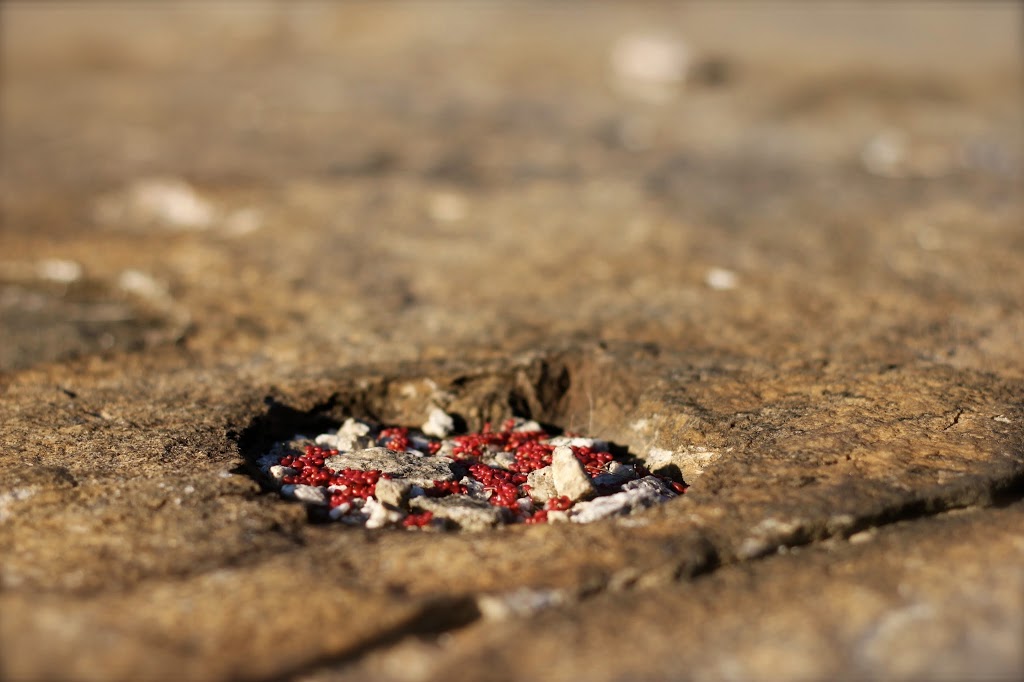 |
| Elf’s Orpine, a granite outcrop specialist |
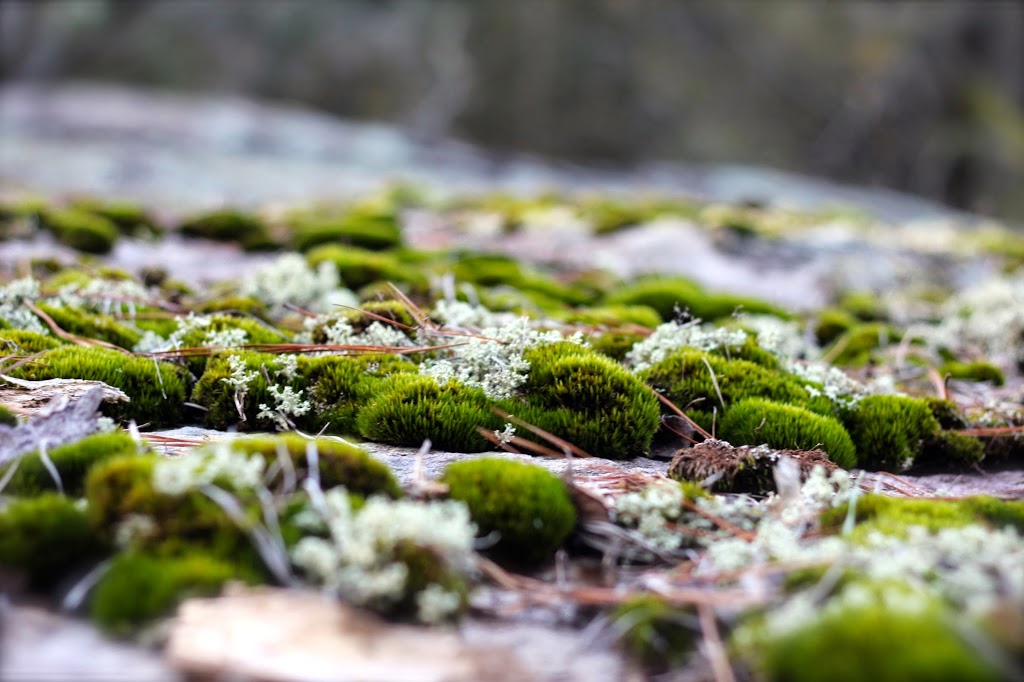 |
| Rock moss and lichen |
 |
| Fern unfurling into Spring |
 |
| Rock moss and lichen, in a battle for dominance |
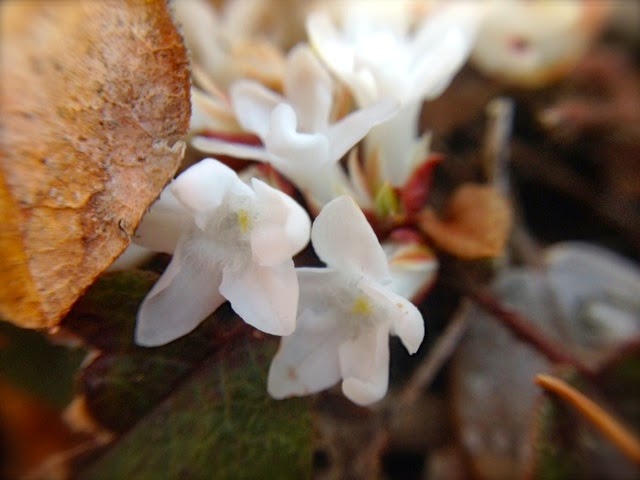 |
| Trailing Arbutus, a new find this year |
Was has your camera helped you find lately?
: )
A hike this afternoon at Arabia Mountain (my favorite local place!) led to a couple good finds. A very brave Jay scooped up this gelatinous mass of salamander eggs(?) from a vernal pool for me to poke and squirm at. There were lots of these (that I’m guessing might be Spotted Salamanders) and a couple of others that maybe are Blue Spotted Salamander eggs.
Very cool, kinda gross and entirely too squishy for my taste.
: )
Probably, I expected that the people who wrote the brochure were exaggerating.
: )
Nope… millions of Trout Lilies bloom in this very special place beside a stretch of highway that looks like every other stretch of highway in GA.
Trout lilies as ground cover, can you imagine?
I suspect that this was, for many years, a closely guarded “secret spot” of the local wildflower enthusiasts. I also suspect that it was only made available for public enjoyment when it became threatened by a road crew or a developer and the locals needed money to preserve it. Not that it matters any; it’s now owned by county government and protected as the treasure it is…
Trout Lilies are a common harbinger of Spring in the Northeast; I don’t believe they’re very common in this part of the country and certainly not in this number. It’s said that this is the largest concentration anywhere. The day we visited was overcast and it was almost dark by the time we found the spot… that’s evidenced by the nearly closed flowers. We also found many, many Spotted Trillium and a couple (impossible to photograph) Twayblade Orchids. I’d think with more time there, I might’ve found all sorts of interesting things.
If you want to go out looking for Trout Lilies in your part of the world, pick a sunny afternoon (when the flowers will be fully open!) and look for them blooming on wet hillsides near streams. They’re a spring ephemeral, so do all their work of blooming and setting seed before the forest canopy puts them into shade for the season. Go early while it’s still freezing cold out. It makes finding them sweeter, trust me. Happy hunting and let me know what you find!